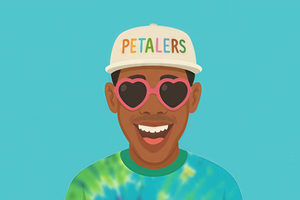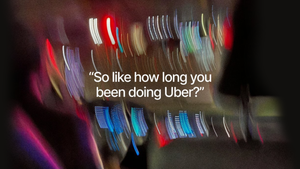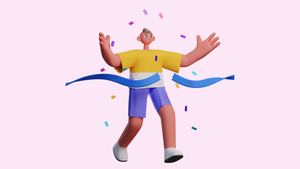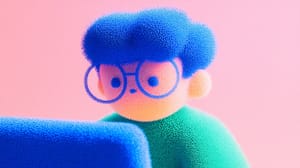Creativity thrives in two modes: uninhibited play and disciplined refinement. “Create like a child, edit like a scientist” succinctly captures this idea. It’s more than clever advice; it’s a practical lens for making better work and navigating the creative process.
This piece unpacks the mindset and shows how to apply it across disciplines.
1 / The mindset behind our best creative work
Why curiosity and play lead us to our best ideas.
“Create like a child, edit like a scientist.”
It’s one of those phrases that instantly clicks; easy to remember, surprisingly deep. Though no single person can lay claim to it, this popular maxim has become a guiding principle for writers, designers, musicians, and artists who understand that the best work often begins with permission to play, followed by the process of refinement.
The phrase has been quietly circulating through creative circles for years, gaining traction on blogs, in writing workshops, and across social media. However, it recently gained new life when Tyler, the Creator, used it to describe his creative process in an interview, sparking a wave of renewed attention. For many, it instantly articulated something they’d always felt but never had words for.
At its core, the maxim taps into a powerful idea: the creative process works best when we refrain from editing too early. Many creatives might feel the need to rush into refinement before an idea’s had a chance to breathe.
They try to make something imaginative and perfect in one go.
But creativity doesn’t work that way. Ideas need room to emerge. When you give them time to take shape, you get to something real, something that wouldn’t surface under pressure.
Similar sentiments have been echoed across generations.
- Ernest Hemingway famously advised, “Write drunk, edit sober.”
- Stephen King put it this way: “Write with the door closed, rewrite with the door open.”
These quotes all point to the same truth: good work depends on giving yourself full permission to explore and experiment, then returning with fresh eyes for critical analysis, deeper thought, and careful refinement.
Let’s explore why this mindset resonates so deeply and how adopting it can unlock better outcomes in UX design, creative work, and life itself.
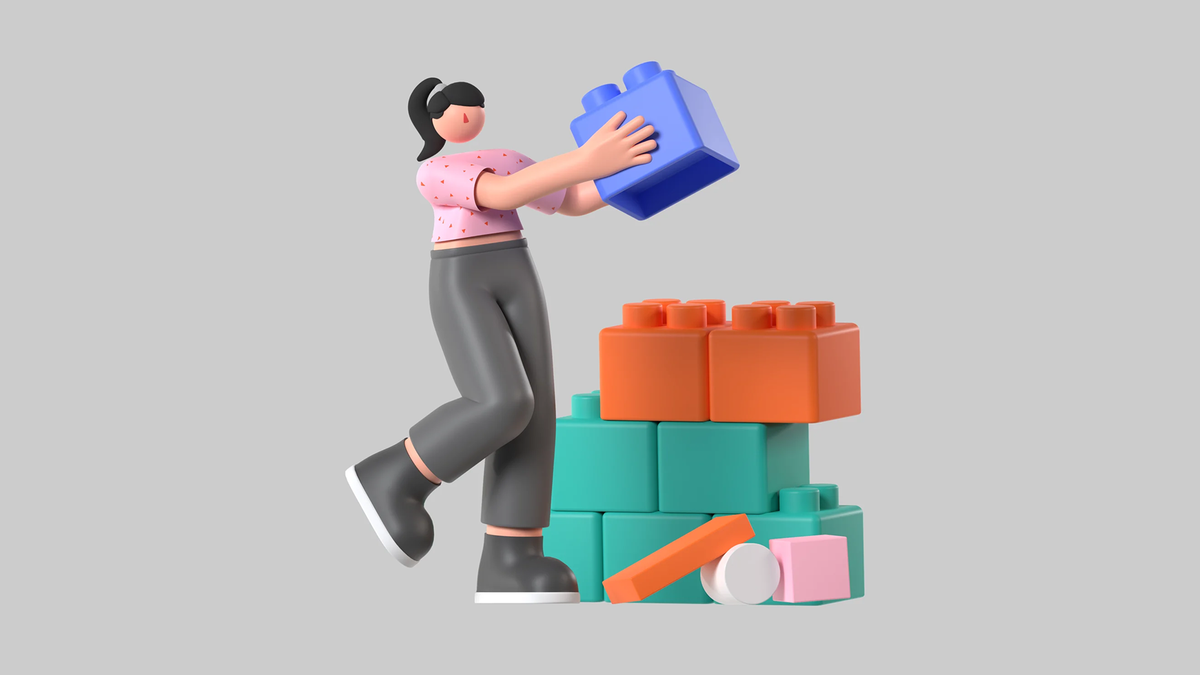
2 / Why the phrase resonates
The wisdom we’re born with, but tend to forget.
At first glance, “Create like a child, edit like a scientist” sounds like simple advice.
But it contains a profound truth about how we work best when we treat creativity and critique as separate modes, each with its own mindset, tempo, and tools.
To create like a child is to explore without fear and judgment.
It’s playful, imaginative, and free of the pressure to get it “right.”
Children don’t hesitate to draw dragons with seven legs or invent stories that make no sense to anyone else. They’re not worried about perfection. They follow curiosity wherever it leads, and that’s often where the most original ideas begin.
To edit like a scientist is to switch gears entirely. This mode is methodical, curious in a different way. It asks: What’s working? What’s not? What can be improved, clarified, or tested? A scientist doesn’t take their first idea personally; they refine it through experiments and feedback. This stage is all about iteration, structure, and smart constraints.
We’re all born with access to both modes. But somewhere along the way, usually through school, social pressure, or the expectation to “perform,” we start collapsing them together. We judge ideas the moment they form. We hesitate to start unless we know where something is going. And as a result, we either block ourselves entirely or produce work that’s safe, expected, and unmemorable.
Psychologists have long described this tension through the lens of divergent and convergent thinking. Divergent thinking opens up possibilities by asking “what if?” and exploring multiple options. Convergent thinking narrows things, applying logic and other realistic factors to arrive at the best solution. Both are essential to creativity, but trying to do both at once short-circuits the process. It’s nearly impossible, nor is it wise, to invent and evaluate at the same time.
This becomes even trickier in the digital age, as tools like Figma, UI kits, Vercel, and Canva collapse creation and editing into a single interface. We can move from idea to pixel-perfect layout in minutes, but that speed can trick us into expecting polish too early. Without intention, we often end up blending modes and rushing the process, instead of switching between them and taking our time.
That’s why the phrase resonates. It doesn’t just sound nice, it gives us a language to name something we’ve always known, but often forget: our best creative work happens when we honor the difference between play and precision.
3 / A creative philosophy in the wild
How artists, musicians, and makers are using it.
The phrase “Create like a child, edit like a scientist” may not have a single origin, but its meaning has clearly struck a chord across the creative world.
It’s been picked up and shared by writers, musicians, designers, and creators of all kinds, not just as advice, but as a creative philosophy that guides how they work.
While the underlying concept has circulated in creative circles for some time, Tyler, the Creator’s recent public endorsement and articulation of the phrase have helped bring it to wider attention, making it more prominent in recent discussions about creativity.
In a widely shared interview from Instagram’s Ask It Anyway series, he explained how his creative process thrives on two distinct energies: an uninhibited, childlike flow when making something new, and a structured, critical mindset when refining it later.
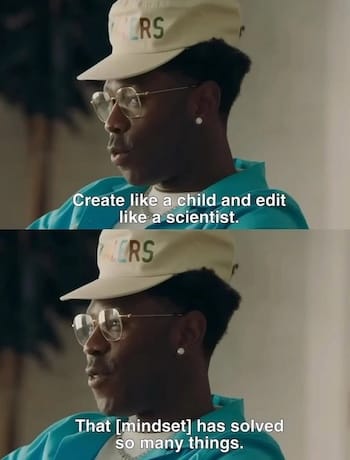
Creatives embrace this philosophy
- Writers have long embraced this idea. Writing freely, then refining. From H.G. Wells’ sandcastle metaphor to Hemingway’s “Write drunk, edit sober,” the message is the same: let ideas form before you start shaping them.
- Musicians and producers describe a similar rhythm: explore and record in the early stages, layer sounds, experiment with texture, then move into edit mode to cut, balance, and refine.
- Artists often start with a messy, impulsive phase, then shift into a slower, more deliberate process where meaning and composition take shape.
- Educators and edtech creators often begin with playful, exploratory methods to spark creativity, then use structured feedback and evaluation to guide progress.
Rick Rubin’s creative process mirrors this mindset.
While he doesn’t use the phrase directly, his approach aligns. In The Creative Act and interviews, Rubin describes the early phase of making as collecting “seeds.” Ideas gathered without judgment, guided by curiosity and openness. He emphasizes experimentation, play, and allowing ideas to unfold without interference. Later comes the discipline: ruthless editing, clear decisions, and a focus on what best serves the work. His four-phase model—Seed, Experimentation, Crafting, and Completion—tracks closely with the principle that great creative work starts with exploration and takes shape through refinement.
The message is clear: Make first, edit later. Creators use it to remind themselves—and each other—that the most important thing is to begin creating.
As creative tools continue to put more power in our hands, making it easier than ever to design, write, or build, the need to separate these two energies becomes even more important.
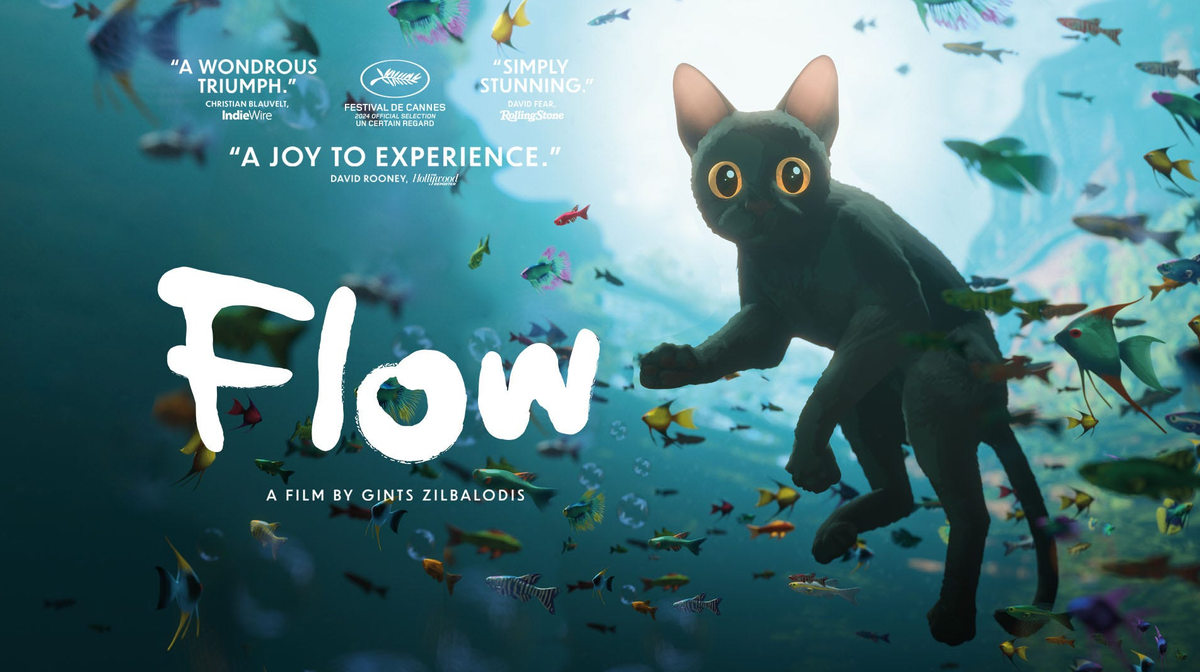
4 / Applying it to UX design
Lead with curiosity; sharpen later.
This mindset is also incredibly useful in design. UX work demands both imagination and pragmatism. But too frequently, we try to hold those two ways of thinking at the same time. That’s when we might miss the best ideas or opportunities. “Create like a child, edit like a scientist” helps by giving each mindset its own space in the process.
Create like a child
Embrace playful ideation
In the early phases of the design, loosen the grip on polish and precision. Sketch loosely, prototype quickly, and let strange ideas surface without filtering them too soon. The goal is to surface possibilities you might not have considered. Treat the process like an open question.
Encourage experimentation
Lean into rapid prototyping, design sprints, and low-fidelity wireframes. These methods are designed to be quick and imperfect. You’re not polishing, you’re exploring. Try things out without worrying if they’ll work. The goal isn’t to be right, it’s to see what’s possible.
Foster curiosity
Look at problems with fresh eyes. Ask “what if?” and “why not?” instead of jumping straight to best practices. When you bring a sense of wonder into the process, you’re more likely to spot unexpected opportunities and design something that stands out.
Edit like a scientist
Test and validate rigorously
Once you have a few directions, it’s time to shift modes. Now you’re asking different questions: What’s working? Where are users getting stuck? What needs to change? Start testing and gathering feedback. Get curious about how people use what you’ve made.
Iterate methodically
This is where structured processes matter—A/B testing, analytics, and heuristic evaluation. Let the data help shape your next steps. Be willing to discard or revise even your favorite ideas if the data doesn’t support them.
Document and reflect
Keep detailed records of what you test and why, so you can learn from failures and successes, just as a scientist would.
In life and work
This mindset also applies to life. It reminds you to give yourself time to explore, and also time to make sense of what you’ve found.
Balance creativity and critique
Start by generating freely; no judgment, no second-guessing. Later, return with a critical lens to refine what’s worth keeping. Keeping those phases distinct helps you move faster, make clearer decisions, and produce sharper work.
Collaborate effectively
In team settings, this mindset can be a game-changer. Allow for open, playful idea sharing, then shift together into a more structured, evaluative mode. Both phases are important, and each requires a different kind of thinking.
The best UX designers I know aren’t just great at tools or trends. They know when to explore possibilities and when to focus on what works. They explore freely, then shape and refine with intention.
5 / Living the mindset
Use it in your life.
“Create like a child, edit like a scientist” isn’t just a work mantra. It’s a way to approach your life with more openness, intention, and self-awareness. At its core, it’s about being playful and curious when you try something new, and reflective and honest when it’s time to grow.
Here’s how it can show up in everyday life.
Create like a child
New experiences don’t always need a plan. Follow curiosity, even if the outcome is unclear. Try things, notice what draws your attention, and don’t overthink whether it “makes sense.” That openness, more exploratory than strategic, is often where the most meaningful shifts begin.
Let yourself try new hobbies, take small risks, and make mistakes without pressure. Be playful. Take a cooking class just because it sounds fun. Say yes to a strange idea. Try something and see what happens. You don’t need a plan to get started.
And keep asking questions. Especially about things you think you already understand. “Why am I doing it this way?” “What if I tried something different?” That childlike curiosity keeps you from getting stuck in default patterns.
Edit like a scientist
Shift gears. Reflect on what worked and what didn’t. Look at your day, your habits, your relationships. What’s adding energy? What’s draining it? What patterns are emerging? This isn’t about being hard on yourself, but rather being honest and thoughtful, like a scientist reviewing an experiment.
Make small changes based on what you notice. Adjust how you spend your time. Try a new way of responding in a tough conversation. You don’t need to overhaul your life; learn from the data of your own experience.
It helps to write things down, too. You don’t have to be a daily journaler, but keeping notes on what you’re trying and what you’re learning helps you stay aware of your own growth. Scientists keep lab notebooks. You can do the same, in your own way.
“Create like a child, edit like a scientist” protects what matters most in creative work: momentum, clarity, and depth. When you separate exploration from evaluation, ideas have room to develop before being shaped. That distinction isn’t just helpful, it’s essential.
In life, the same applies. Releasing control gives you space to learn, adapt, and stay curious. You stop expecting precision on the first try and start trusting that clarity will come through the process. Over time, that builds creative resilience, sharper thinking, and a way of working that’s both grounded and alive.

